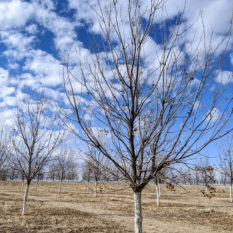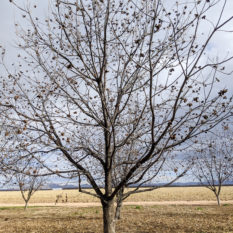Training Pecan Trees, Setting Some Limits
Training young pecan trees is essential to helping the tree develop a strong support structure.
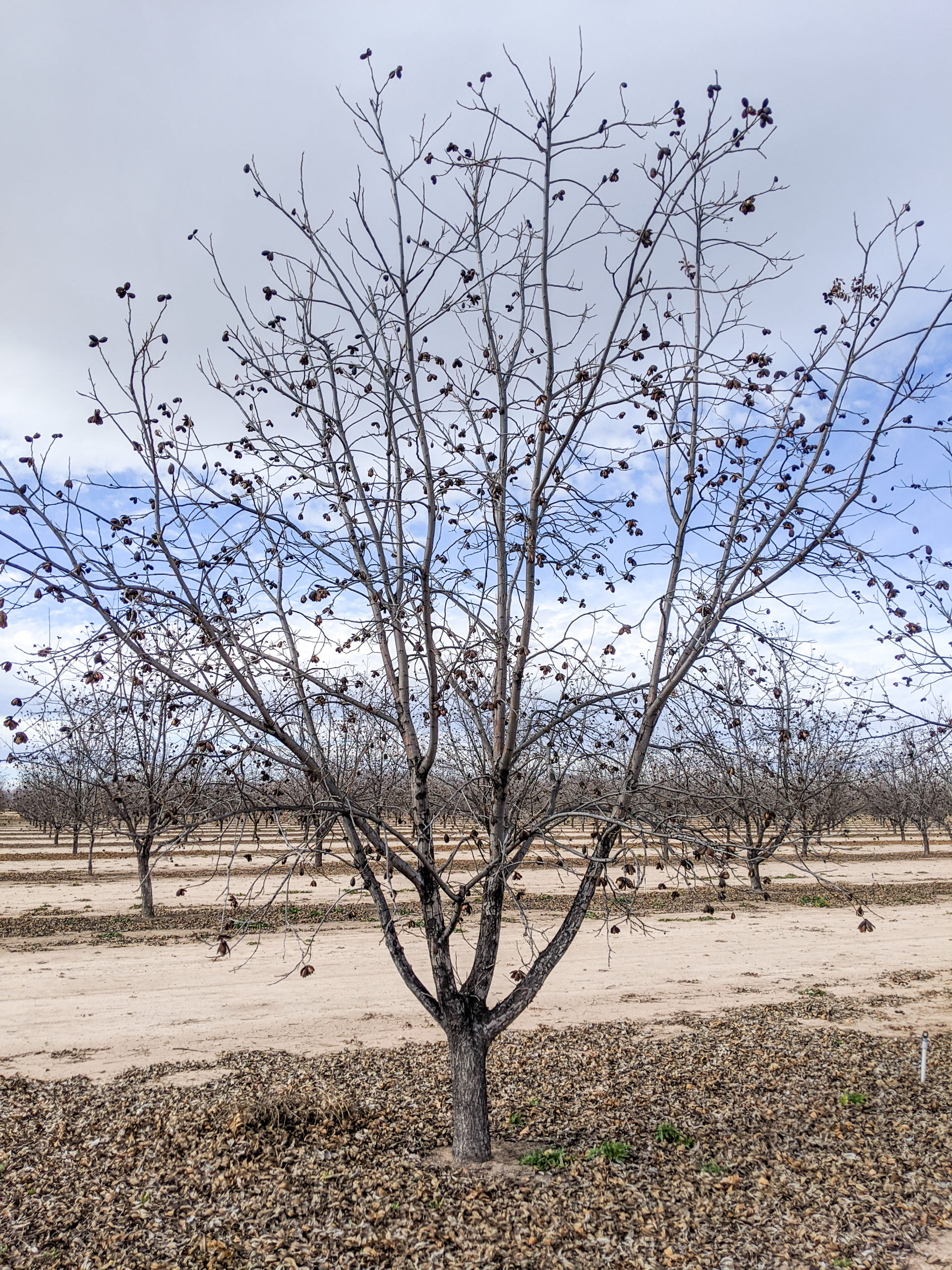
An improperly trained tree or one with little to “no” pruning while young. (Photo by Joshua Sherman)
If you think about it, this can be true in many aspects of our pecan farms, and especially true when it comes to training up the young pecan trees. Why do we need to train our young pecan trees? Simply, the majority of our trees planted out here have skipped their juvenile stage of development because they have been grafted. Skipping this stage means that the trees tend to develop a branching habit at the get-go from the first year planted in the ground. It is not recommended to allow this growth to progress, but rather to train them.
Ultimately, when we train young pecan trees, we aid them in becoming strong support structures to perform well when the fruit load develops later. This early training will provide the tree the capability of handling other stresses as well, such as weather extremes (strong winds), harvesting, and other cultural practices when they become mature.
Just look at the pecan tree in nature. When observing a native pecan, or one developed from a seedling, the natural habit of a central leader can be distinguished. This strong central leader evolved as it supplies the support for the scaffold branches that hold most of the crop load.
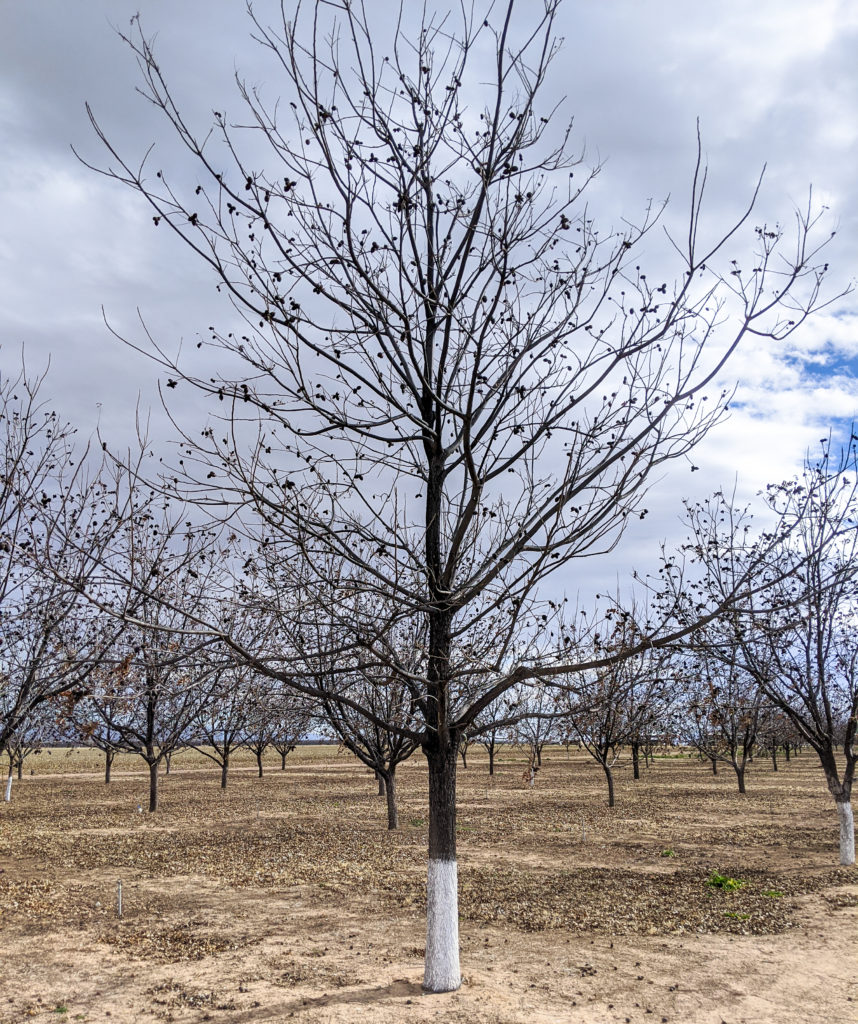
This seedling tree lost its graft. Notice it developed into its natural strong, central leader. (Photo by Joshua Sherman)
First Leaf Training
For a young pecan tree’s “first-leaf”—that is, the first year in your orchard floor and soil—the dormant, bareroot trees usually come pruned with a heading cut and ready to be planted.
For those of you who grow from your own nursery, give the dormant tree a heading cut of one-third to half of the previous season’s growth before planting. This heading cut is done first to encourage upright shoot growth from nodes just below the cut point, and some pruning of the roots is encouraged to aid in new root development as well. For definitions of pruning terminology used, please refer to the Pecan South article “Training Pecans for Performance, Perseverance & Productivity” in the January 2018 issue.
During the first-leaf season, you may notice some trees not performing like the others or poorly developing. If good growth has not been seen by July, give another heading cut to a foot above the graft union to force growth. If there is still no growth, there may be another issue to investigate, either below the soil surface or the depth at which it was planted.
Most newly planted young pecan trees are also given a sleeve to protect the tender young trunk from being scarred by equipment, sun damage, or herbicide damage. Most times, shoots emerge inside these sleeves. I usually advise removing these with a thinning cut, especially if threatened by herbicide sprays. It also will direct energy toward the top of the tree, where we want it. Other than that, simply let the tree take root and develop.
Second to Fourth Leaf Training
To promote the central leader framework during each dormant pruning season, approach the pecan tree with a focus on the dominant, most vigorous shoot you want to keep as the main central leader. Once that is chosen, give a thinning cut (a cut back to the point of origin) to all other dominant, vertical shoots that are competing with this one you have chosen to keep.
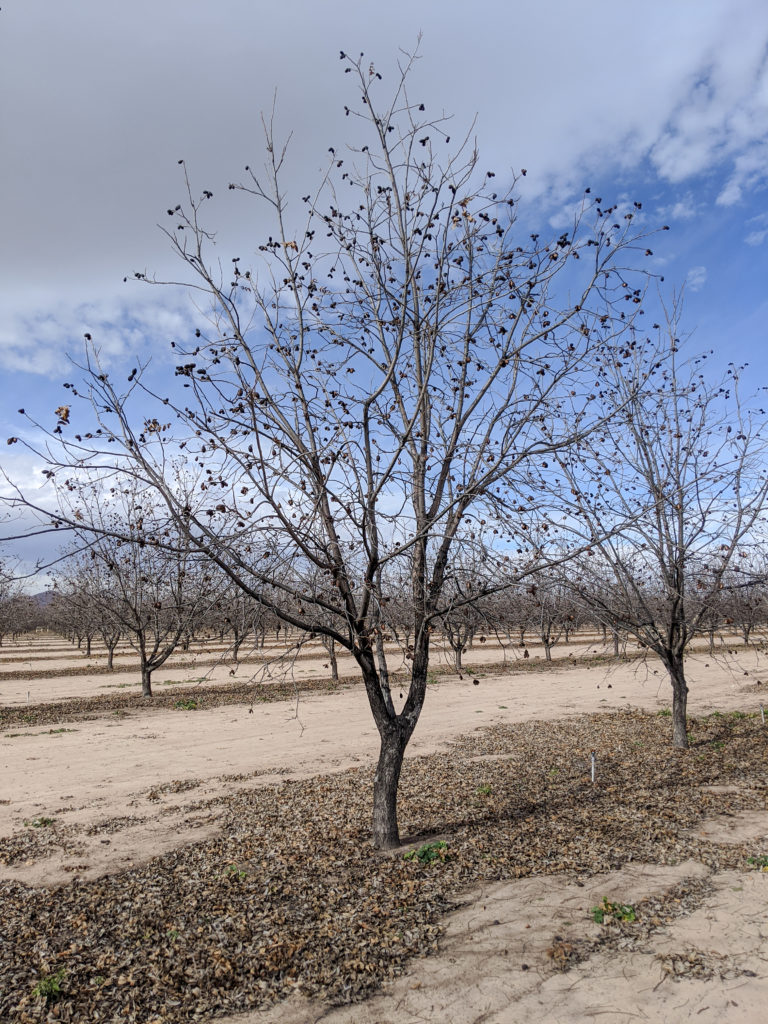
This tree developed “Y-Shaped” branching due to improper training while young. Limb splitting is likely here. (Photo by Joshua Sherman)
There are sometimes two or three dominant vertical shoots competing with each other. In this case, it is advised in the Southwest to choose the one growing into the prevailing wind, or close to, and give a thinning cut to the other competing dominant shoots.
After you have chosen your central leader and removed the competing shoots, give a heading cut back to this central leader to one-third or half its total length. When you’re looking where to make the heading cut, look for just above a nice, fat bud. Then, make the cut a quarter to half an inch above that bud.
After that is done, the next step is only to be performed on this new central leader. Grab the shoot with a gloved hand just below the top four or five buds and rub down the rest of the shoot, removing all the lower primary buds. This removal will direct energy, specifically growth hormones, to those terminal buds at the top to encourage new vigorous growth in the coming season, and thus a strong newly developing central leader to be chosen the next pruning season.
Scaffold Limb Training
It is not recommended to begin choosing scaffold limbs until after the first or second dormant season. According to New Mexico State University’s Richard Heerema, the main goal to keep in mind is to leave “6 to 10 scaffold branches spaced 8 to 14 inches apart and arranged in a spiral around the central leader.” You should select scaffold limbs that are wide-angled, greater than 45 degrees from the central leader. This crotch angle will prevent breakage or splitting of the branch in high winds or heavy crop load.
Once the unwanted lower scaffold branches are 1 inch in diameter, they should then be removed, so they do not interfere with harvest equipment. A thinning cut, back to the point of origin, is used for these. This period is also when the pecan trunks’ “skirt” height is determined. The “skirt” is used sometimes in reference to how high the cleaned-up trunk is allowed.
In-Season Training
During the active growing season, some things can be done in regard to training the young pecan tree. Usually, these things include pinching on the lower lateral shoots, not any of the top shoots that are developing to be central leader options. Only pinch the new growth (light green in color) on 12- to 18-inch long shoots in its first-leaf, and 12 to 32 inches long during the second-, third- and fourth-leaf growing seasons. Again, also remove any shoots developing inside the protective sleeves; these shoots steal energy from the top growth.
Completely pinching out a shoot can also be utilized during the growing season on soft developing shoots once you see them becoming problematic if left to grow throughout the season. For example, problematic shoots include those that would eventually begin to rub against another limb.
In Summary
Some foresight should be used when choosing which limbs to leave on the tree and which to remove; ultimately, you should think about the future of that limb if left on the tree and what impact it will have on the tree as a whole.
I defer again to the words of Richard Heerema in New Mexico State University’s Guide H-605, “Training Young Pecan Trees”: “As you train your trees, keep a mental image of the ideal structure you wish to maintain and shape each of your trees to this pattern. This will serve you as a standard. However, no two trees are alike, and you will find as you are pruning, not all, if few, will conform exactly to your ideal shape.”
There is a lot to think about when planning for the pruning project too. Take your time preparing and gathering tools for the pruning. Don’t forget eye protection, especially—those don’t grow back—and also hand and ear protection if using a chainsaw. Take your time performing the cuts, don’t be in a hurry, but use the pruners deliberately with a solid hold on the handles. Make sure you are using the right pruners and loppers, too, not the anvil style. Freshly clean, sharpen, and oil if necessary. You should plan to take a folding saw and a sharpening file with you for the loppers and hand pruners as they will get dull as you move across the orchard. The majority of accidents happen due to dull blades.
At any time during the training period, if you have a “Y-shaped” tree created by just two dominant central leaders, it is highly encouraged to remove one of those central leaders. If left “Y-shaped” the chances are very high that the tree trunk will split down the middle at some point in its life.
Usually, by the fifth and sixth leaf, the central leader you have helped train can now be left to develop on its own naturally. From now on the rest of your task is to focus on removing dead or diseased limbs, or limbs that are growing into one another, and also to start planning your mechanical pruning strategy (such as topping and hedging) for when fruiting becomes prominent.
Lastly, let’s circle back to Chris Blanchard’s quote on setting limits. Setting limits is ultimately what we are doing by training the pecan tree. We are establishing limitations on how it supports the fruiting load once it develops, and thus, not becoming a “slave to the two-year-old,” or to the trees in this case, by having to correct issues every year down the road caused by improper training when they were young. It is understandable to think, and I’ve heard spoken before, “pruning out those limbs is setting them back or removing what would become fruitwood earlier on.” Still, in my discipline as a horticulturist and my experience in arboriculture, I want to emphasize there are decades of research proving in other nut and fruit trees, even fruiting vines, if the right support structure is not trained early on to be able to support their fruit load later, the setback will be even larger when these trees mature and substantial limb breakage occurs. Training of ornamental trees in the landscape is true in this regard as well.
So, I highly encourage and recommend taking that minimal setback early, pruning those trees, and training them properly while young. The pecan trees are very resilient to pruning. After all, for almost all cultivars in pecan production, the fruit development doesn’t initiate until year 5 or 6 anyway. Plus, are we not in the commercial production of pecans? Do you not want to encourage proper support and structure for when the trees reach their maximum production potential and minimize your losses later?

